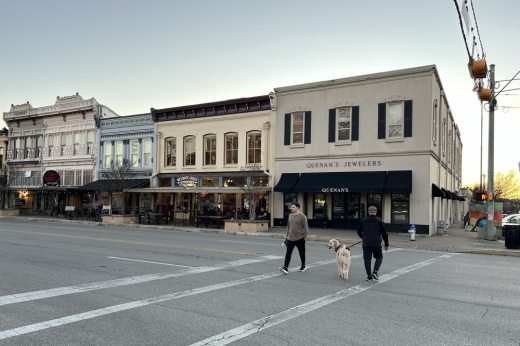After over an hour of debate, council members agreed to modify the maximum heights that were introduced in February as part of the city’s Downtown Master Plan.
“I think we have a tremendous responsibility to preserve the look and feel of Georgetown,” said council member Jake French, who represents downtown residents.
What happened
The proposed regulations state that most buildings in downtown Georgetown may not be taller than the Williamson County Courthouse, which is 57.5 feet tall. Buildings in the downtown area are currently limited to 40 feet.
Council members opted to limit new development in Zone 4—which includes many properties outside the town square—to 52 feet. Zone 4 is labeled in blue on the map below.

“I've looked at this, and I just really feel, based on my experience in urban planning and architecture, that allowing four-story buildings in our historic downtown would overpower the charm and uniqueness that we have that we've been protecting for so long,” Olson told City Council on March 26. “And then also significantly increase the traffic and parking congestion on narrow streets in downtown and in old town.”
Over 60 Georgetown residents shared comments about the plan during the State of the City event March 21. None of them were in favor of buildings taller than 52 feet in Zone 4, urban design consultant Chris Geddes said.
Council members also recommended:
- Removing limits on the maximum number of stories for new buildings in Zone 2, which includes properties adjacent to the county courthouse. The maximum proposed height for this zone is 50 feet. Previous proposals limited new development in this area to three stories. This area is indicated in orange on the map.
- Combining Zone 3 (indicated in yellow) and Zone 6 (indicated in purple). Buildings in this area would be limited to two stories and 35 feet.
- Limiting development in Zone 5, which includes properties of “exceptional value” in the northern sector of downtown, to 64 feet. This area is indicated in dark blue.
What they’re saying
“I've heard the argument that we need increased height and density, and the associated tax revenue, to make the sort of improvements that we keep will keep our downtown vital and active,” French said. “But I think the risk of damaging the character of our downtown is too great” to allow developers to construct 57.5-foot buildings.
French said council members visited other cities, such as McKinney and Grapevine in the Dallas-Fort Worth area, to get a feel for how local leaders have approached development. French said he did not remember seeing any four-story, 57.5-foot buildings in those communities.
“One of my top priorities is always citizen feedback,” council member Amanda Parr said. “And I think on this one, we have heard loud and clear from what our citizens want here in the city of Georgetown: they're willing to stretch a little bit; they're just asking us to not stretch quite so far.”
Four council members—French, Parr, Kevin Pitts and Mike Triggs—voted to limit new development in Zone 4 to 52 feet. Three council members—Ron Garland, Ben Stewart and Shawn Hood—voted to limit development in the area to 57.5 feet.
Also of note
Olson said several residents of Sun City, an age-restricted community in northern Georgetown, told him increased development and a lack of parking would discourage them from visiting downtown.
“We need to make sure whatever we do to downtown is for all neighborhoods, and it welcomes and accommodates all neighborhoods, no matter how young, middle-aged or old,” Olson said. “That's really critical, and I think that by keeping the density down, that'll help.”
Triggs said he heard similar concerns from Sun City residents.
“When you cut out that demographic that has money to spend, and you say you don't want them downtown anymore, I don’t think you’re gonna get the development that you want,” Triggs said. “I don't want to see a boarded-up downtown. ... I can pick out five, maybe six businesses on the Square that are going to suffer from not having Sun City people go downtown.”
More details
Officials also plan to enhance bicycle and pedestrian access throughout the downtown area; create new public event spaces; improve seating and lighting; and increase parking under the Downtown Master Plan.
The plan was first adopted in 2003. City officials first updated the plan in 2013 and began working on the second update in October 2022.





